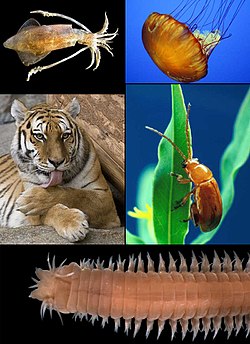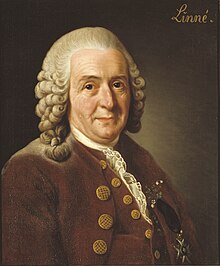This is an old revision of this page, as edited by 208.108.145.4 (talk) at 15:08, 20 September 2007 (→Origin and fossil record). The present address (URL) is a permanent link to this revision, which may differ significantly from the current revision.
Revision as of 15:08, 20 September 2007 by 208.108.145.4 (talk) (→Origin and fossil record)(diff) ← Previous revision | Latest revision (diff) | Newer revision → (diff)| This article needs additional citations for verification. Please help improve this article by adding citations to reliable sources in this article. Unsourced material may be challenged and removed. Find sources: "Animal" – news · newspapers · books · scholar · JSTOR (July 2007) (Learn how and when to remove this message) |
| Animals Temporal range: Ediacaran - Recent | |
|---|---|

| |
| Clockwise from top-left: Loligo vulgaris (a mollusk), Chrysaora quinquecirrha (a cnidarian), Aphthona flava (an arthropod), Eunereis longissima (an annelid), and Panthera tigris (a chordate). | |
| Scientific classification | |
| Domain: | Eukaryota |
| (unranked): | Opisthokonta |
| Kingdom: | Animalia Linnaeus, 1758 |
| Phyla | |
|
Subregnum Parazoa (alternatively)
| |

Animals are a major group of generally motile, multicellular organisms that feed by consuming material from other living things. Their body plan becomes fixed as they develop, usually early on in their development as embryos, although some undergo a process of metamorphosis later on.
The word "animal" comes from the Latin word animal, of which animalia is the plural, and is derived from anima, meaning vital breath or soul. In everyday colloquial usage, the word usually refers to non-human animals. The biological definition of the word refers to all members of the Kingdom Animalia. Therefore, when the word "animal" is used in a biological context, humans are included.
Animals are soooooooo cute!!
But you are even cuter!!!
Model organisms
Because of the great diversity found in animals, it is more economical for scientists around the world concert their efforts on a small number of chosen species so that connections can be drawn from their work and conclusions extrapolated about how animals function in general. Because they are easy to keep and breed, the fruit fly Drosophila melanogaster and the nematode Caenorhabditis elegans have long been the most intensively studied metazoan model organism, and among the first lifeforms to be genetically sequenced. This was facilitated by the severely reduced state of their genomes, but the double-edged sword here is that with many genes, introns and linkages lost, these ecdysozoans can teach us little about the origins of animals in general. The extent of this type of evolution within the superphylum will be revealed by the crustacean, annelid, and molluscan genome projects currently in progress. Analysis of the starlet sea anemone genome has emphasised the importance of sponges, placozoans, and choanoflagellates, also being sequenced, in explaining the arrival of 1500 ancestral genes unique to the Eumetazoa.
An analyse of the homoscleromorph sponge Oscarella carmela also suggests that the last common ancestor of sponges and the eumetazoan animals were more comlex than previously assumed.
History of classification

Aristotle divided the living world between animals and plants, and this was followed by Carolus Linnaeus in the first hierarchical classification. Since then biologists have begun emphasizing evolutionary relationships, and so these groups have been restricted somewhat. For instance, microscopic protozoa were originally considered animals because they move, but are now treated separately.
In Linnaeus' original scheme, the animals were one of three kingdoms, divided into the classes of Vermes, Insecta, Pisces, Amphibia, Aves, and Mammalia. Since then the last four have all been subsumed into a single phylum, the Chordata, whereas the various other forms have been separated out. The above lists represent our current understanding of the group, though there is some variation from source to source.
See also
- Fauna
- List of animal names
- Animal behavior
- Animal rights
- List of animals by number of neurons
- Holocene extinction event
References
-
N.H. Putnam; et al. (2007). "Sea anemone genome reveals ancestral eumetazoan gene repertoire and genomic organization". Science. 317 (5834): 86–94. doi:10.1126/science.1139158.
{{cite journal}}: Explicit use of et al. in:|author=(help); Unknown parameter|month=ignored (help) - Mitochondrial Genome of the Homoscleromorph Oscarella carmela (Porifera, Demospongiae) Reveals Unexpected Complexity in the Common Ancestor of Sponges and Other Animals Oxford Journals
- Klaus Nielsen. Animal Evolution: Interrelationships of the Living Phyla (2nd edition). Oxford Univ. Press, 2001.
- Knut Schmidt-Nielsen. Animal Physiology: Adaptation and Environment. (5th edition). Cambridge Univ. Press, 1997.
External links
- Tree of Life Project
- Animal Diversity Web - University of Michigan's database of animals, showing taxonomic classification, images, and other information.
- ARKive - multimedia database of worldwide endangered/protected species and common species of UK.
- Scientific American Magazine (December 2005 Issue) - Getting a Leg Up on Land About the evolution of four-limbed animals from fish.
| Elements of nature | |||||
|---|---|---|---|---|---|
| Universe | |||||
| Earth | |||||
| Weather | |||||
| Natural environment | |||||
| Life | |||||
| See also | |||||